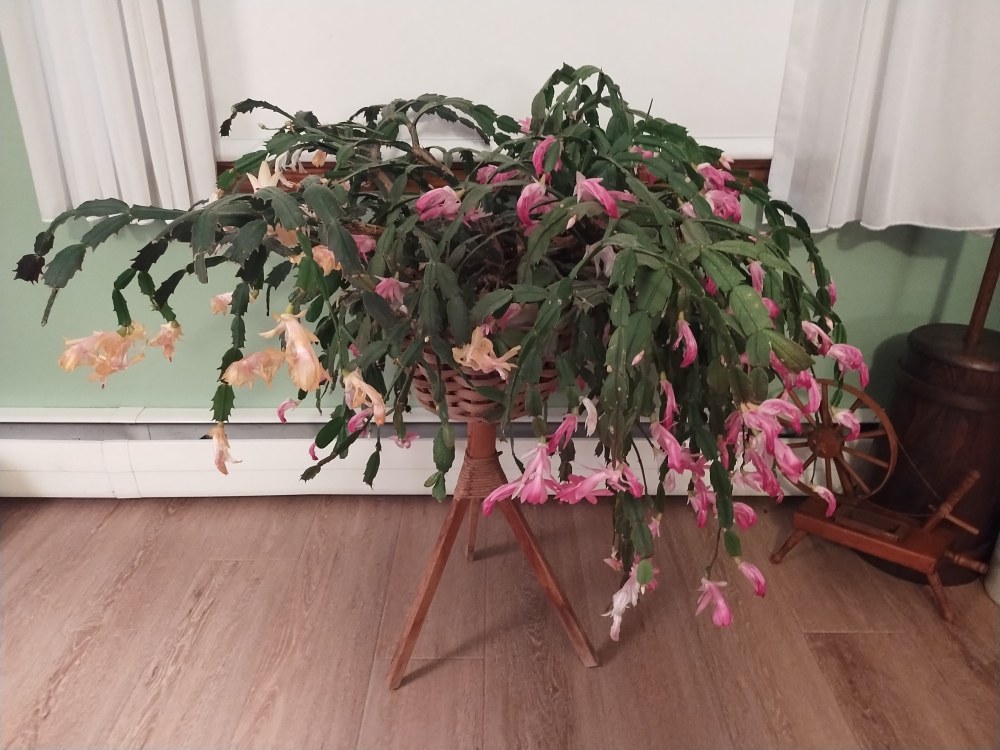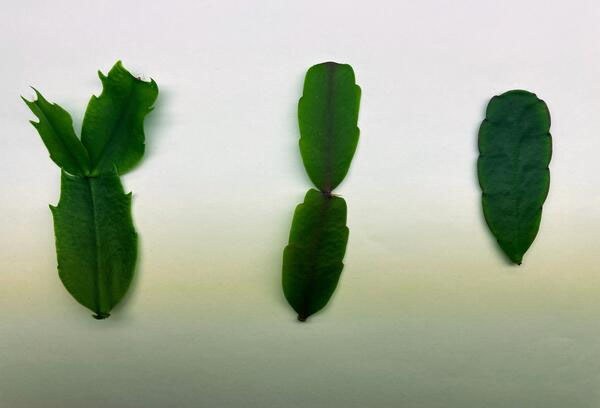Posted: December 2, 2024
Holiday cacti are popular houseplants for southcentral Pennsylvania. They add bright spots of color indoors and work well in containers and hanging baskets.

Figure 1. Indoor arrangement of mixed holiday cacti species. Photo credit: Jennie Mazzone, Penn State.
There are many choices for holiday cacti flower color including white, red, lavender, pink, and orange (Figure 1). The timing of the flowering will depend on the species of holiday cactus.
There are three common species of holiday cacti:
- Thanksgiving cactus (Schlumbergera truncate)
- Christmas cactus (Schlumbergera × buckleyi)
- Easter cactus (Rhipsalidopsis gaertneri)
All three cacti are short-day plants, needing 12–4 hours of uninterrupted darkness per day to set buds for flowering. Short days like this occur in southcentral Pennsylvania as the winter solstice approaches in late December. The exact bloom time is determined by the number of consecutive short days required for each species. Thanksgiving and Christmas cacti require 6 weeks of short days. Under natural window light in southcentral Pennsylvania, Thanksgiving cactus blooms usually begin in mid-November. Christmas cactus blooms typically begin shortly after in December. Easter cactus requires 8–12 weeks of short days, typically blooming between March and May in southcentral Pennsylvania. Exact bloom times can vary depending on light exposure and temperature. Cooler nighttime temperatures, 55 to 65°F in late fall, can promote blooming.
Holiday cacti can be identified by their leaf-like, green, segmented stems (Figure 2). Thanksgiving cactus segments have pointed projections along their margins. Christmas cactus segments have scalloped-shaped margins. Easter cactus has smaller, rounded stem segments with bristly spines.

Figure 2. Thanksgiving cactus (left) has pointed margins. Christmas cactus (center) has scalloped margins. Easter cactus (right) has rounded margins. Photo credit: Ken Johnson, University of Illinois Extension.
With proper care, a holiday cactus will reward you with beautiful blooms year after year, adding a festive touch of color to your home during the holiday season.
Holiday Cacti Care
Light: Place your plant in an area of bright, indirect light. Holiday cacti are short-day plants (days shorter, nights longer). They need 12–14 hours of uninterrupted darkness per day to set buds for flowering. Flower buds will not set if the darkness is interrupted for too long (2+ hours). Plants must also be kept in areas away from artificial light sources such as lamps and streetlights for uninterrupted darkness to occur.
After temperatures warm up in the spring, plants can be set outside in light shade. Too much light and sun can sunburn the plants. Keeping plants outside until cold weather sets in early fall can help flower buds form.
Temperature: Holiday cacti prefer temperatures between 70 and 80°F during the day and slightly cooler, 55 to 65°F, at night. Cooler temperatures, between 55 and 65°F in fall, will promote flowering. Indoors, plants can be maintained between 60 and 70°F. Keep plants away from drafts and heating vents.
Watering: Test the top of the soil for dryness. Water from the top down, wetting the potting soil thoroughly. When the soil becomes dry, water again. While budding and flowering, keep the soil evenly moist but avoid overwatering. If conditions dry out too much while in flower, the buds or flowers will drop off prematurely. Be sure there is proper drainage to prevent root rot.
Humidity: Holiday cacti appreciate humidity. Bathrooms and kitchens can provide higher humidity indoor environments. Increase humidity by misting the plant.
Fertilization: Feed your cactus monthly during the growing season (spring and summer) with a balanced, water-soluble fertilizer. Reduce feeding during the fall and winter.
Flowering: To encourage blooms, provide a period of darkness (12–14 hours) each day for the required timeframe. This mimics the natural shortening of days and stimulates flower buds to form. Holiday cacti flowers will last longer in cooler temperatures. Ideal growing temperatures range from 55 to 65°F at night and 70°F during the day.
After-bloom Care: Once flowering ends, plants can be pruned to encourage new growth and maintain their shape. Move the plant to a slightly cooler area and water less frequently.
Holiday cacti can rebloom at other times of the year. After blooming, water less frequently.
These plants can be easily propagated. More information on propagation is provided in the Penn State Extension article Holiday Cacti Care.
References
Iowa State University: All About Holiday Cacti
Iowa State University: Is it a Thanksgiving, Christmas, or Easter Cactus?
Michigan State University Extension: How to care for and get your holiday cactus to rebloom
North Carolina Extension Toolbox: Christmas Cactus
Penn State Extension: Holiday Cacti Care
University of Illinois Extension: How to identify and care for holiday cacti and get them to rebloom
Authors
Carol Kagan
Master Gardener, Franklin County
Jennie Diehl Mazzone
Master Gardener Coordinator, Franklin County

